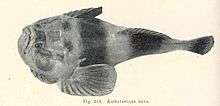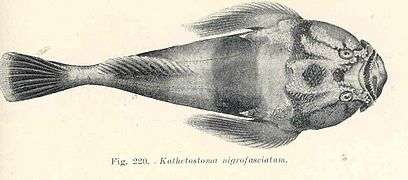Stargazer (fish)
The stargazers are a family, Uranoscopidae, of perciform fish that have eyes on top of their heads (hence the name). The family includes about 51 species (one extinct) in eight genera, all marine and found worldwide in shallow and deep saltwaters.[1]
| Stargazer | |
|---|---|
 | |
| Common stargazer, Kathetostoma laeve | |
| Scientific classification | |
| Kingdom: | Animalia |
| Phylum: | Chordata |
| Class: | Actinopterygii |
| Order: | Trachiniformes |
| Family: | Uranoscopidae Jordan & Evermann, 1898 |
| Genera | |
|
See text | |
In addition to the top-mounted eyes, a stargazer also has a large, upward-facing mouth in a large head. Their usual habit is to bury themselves in sand, and leap upwards to ambush prey (benthic fish and invertebrates) that pass overhead. Some species have a worm-shaped lure growing out of the floors of their mouths, which they can wiggle to attract prey's attention. Both the dorsal and anal fins are relatively long; some lack dorsal spines. Lengths range from 18 up to 90 cm, for the giant stargazer Kathetostoma giganteum.
Stargazers are venomous; they have two large venomous spines situated behind their opercles and above their pectoral fins. The species within the genera Astroscopus and Uranoscopus can also cause electric shocks. Astroscopus species have a single electric organ consisting of modified eye muscles, while Uranoscopus species have theirs derived from sonic muscles.[2] These two genera within stargazers are out of eight total independent evolutions of bioelectrogenesis.[2] They are also unique among electric fish in not possessing specialized electroreceptors.[3]
Stargazers are a delicacy in some cultures (the venom is not poisonous when eaten), and they can be found for sale in some fish markets with the electric organ removed. Because stargazers are ambush predators which camouflage themselves and some can deliver both venom and electric shocks, they have been called "the meanest things in creation."[4]
Genera
 Deepwater stargazer
Deepwater stargazer
(Kathetostoma nigrofasciatum)- Northern stargazer
(Astroscopus guttatus)  Whitemargin stargazer
Whitemargin stargazer
(Uranoscopus sulphureus) Southern stargazer
Southern stargazer
(Astroscopus y-graecum)
Timeline

References
- Froese, Rainer, and Daniel Pauly, eds. (2006). "Uranoscopidae" in FishBase. May 2006 version.
- Gomon, M.F.; Roberts, C.D. (2011). "A second New Zealand species of the stargazer genus Kathetostoma (Trachinoidei: Uranoscopidae)". Zootaxa. 2776: 1–12.
- Bray, Dianne. "Family URANOSCOPIDAE". Fishes of Australia. Retrieved 30 September 2014.
- Alves-Gomes, J.A. (2001). "The evolution of electroreception and bioelectrogenesis in teleost fish: a phylogenetic perspective". Journal of Fish Biology. 58 (6): 1489–1511. doi:10.1006/jfbi.2001.1625.
- Alves-Gomes, J. A. (2001). "The evolution of electroreception and bioelectrogenesis in teleost fish: a phylogenetic perspective". Journal of Fish Biology. 58 (6): 1489–1511. doi:10.1111/j.1095-8649.2001.tb02307.x.
- Grady, Denise Venom Runs Thick in Fish Families, Researchers Learn New York Times 22 August 2006.
External links
| External video | |
|---|---|
| Wikimedia Commons has media related to Uranoscopidae. |